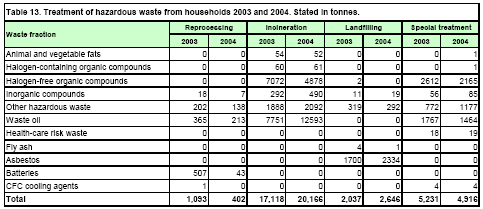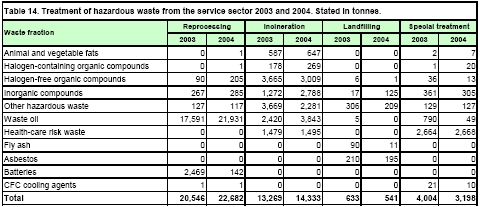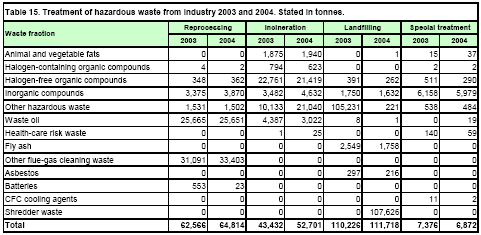|
| Front page | | Contents | | Previous | | Next |
Environmental Review, 1/2006
3 Hazardous waste
Table 12 shows treatment of hazardous waste in 2003 and 2004 by main group. The statement covers waste from both primary and secondary sources. A more detailed statement of hazardous waste,
analysed by ISAG fractions is available in Annex 4. Table 12 has been changed somewhat from previous years to make it more comprehensible. This means that certain fractions are now only found in
Annex 4.
Waste from secondary sources, such as waste from incineration plants, is not included in total waste generation, cf. Table 1. This is because the waste would otherwise be counted twice in the statistics: the
first time upon receipt at the primary treatment plant and the second time as a residue. However, it may be reasonable to include waste from both primary and secondary sources when estimating capacity
needs for hazardous waste management.
Click here to see the Table.
Source: ISAG reports 2003 and 2004, and (1) Registrations under the EU regulation on shipments of waste. (2) Danish EPA calculations. Double reporting may have occurred, because some of the
hermetically sealed Ni-Cd batteries may have been included in the amount of batteries reported to the ISAG. (3) Elsam and Energi E2. (4) Based on the ISAG. It is expected that waste from secondary
sources will be exported and landfilled abroad.
The table shows that hazardous waste from primary sources amounted to 342,025 tonnes in 2004. This is an increase of 13,676 tonnes from 2003. The three fractions which have gone up the most are:
waste oil, inorganic compounds, and other flue-gas waste.
The Figure also shows that the amount of shredder waste has gone from 0 to 107,626 tonnes in 2004. This is because in 2003, we chose to register shredder waste under the category "other hazardous
waste". Since shredder waste is reported as landfilled waste exempted from tax, the ISAG leaves no other option than including it under "other hazardous waste". This waste fraction, however, is so large
that this year we chose to include shredder waste in the statistics separately. This, then, results in a fall in the amount of "other hazardous waste", which went from 127,807 tonnes in 2003 to 33,653 tonnes
in 2004.
The amount of shredder waste was around 100,000 tonnes in 2003.
Hazardous waste from secondary sources amounted to 86,834 tonnes in 2004, which is 1,302 tonnes less than in 2003.
Tables 13 to 16 show the amounts of waste generated by the four sectors: households, service, industry, and building and construction.

Source: ISAG 2002 and 2003.

Source: ISAG 2002 and 2003.

Source: ISAG 2002 and 2003.
Click here to see the Table.
Source: ISAG 2002 and 2003.
The total amount of hazardous waste from industry is 236,105 tonnes, whereas the total amount from the service sector is 40,754 tonnes, the total amount from households is 28,130 tonnes, and the total
amount from building and construction is 17,980 tonnes. A comparison of the total amounts of hazardous waste from the four sectors shows that industry generated almost three times as much hazardous
waste as the three remaining sectors put together.
The building and construction sector, which generates least hazardous waste, has one primary source of hazardous waste, namely asbestos. Asbestos is also present in other sectors, however in significantly
smaller quantities.
Healthcare risk waste from the service sector, or more precisely from hospitals, is another hazardous waste fraction primarily originating from one sector.
The three fractions waste oil, halogen-free organic compounds, and other hazardous waste occur in the largest amounts in industry, the service sector, and households. Organic compounds without halogens
include e.g. solvents, dye/varnish/paint and tar, and rust-preventing oils.
Inorganic compounds are found in significant amounts in both industry and the service sector. This fraction is found only in small amounts in both households and the building and construction sector.
| Front page | | Contents | | Previous | | Next | | Top |
Version 1.0 February 2006, © Danish Environmental Protection Agency
|